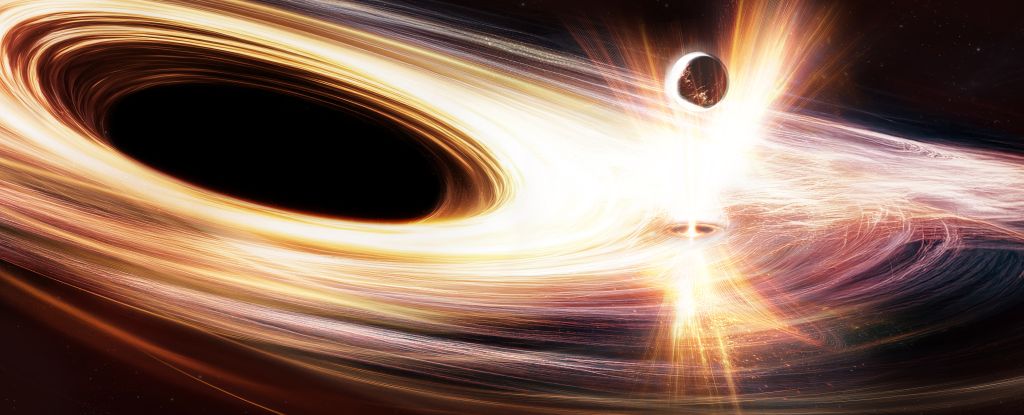Awakening Black Gap’s Wild Conduct Has Astronomers Stumped : ScienceAlert

A supermassive black gap 300 million light-years away has astrophysicists stumped.
It lurks on the middle of a galaxy referred to as SDSS1335+0728, and, since 2019, researchers have been watching in real-time because it awoke from a quiescent slumber and began blazing with exercise, belching out a collection of eruptions of sunshine.
This in itself is according to how we all know supermassive black holes to behave. However the conduct of this specific black gap – nicknamed Ansky – is so bizarre and wild that it is difficult to elucidate.
“The bursts of X-rays from Ansky are 10 occasions longer and 10 occasions extra luminous than what we see from a typical quasi-periodic eruption,” says astrophysicist Joheen Chakraborty of MIT.
“Every of those eruptions is releasing 100 occasions extra vitality than we now have seen elsewhere. Ansky’s eruptions additionally present the longest cadence ever noticed, of about 4.5 days. This pushes our fashions to their limits and challenges our current concepts about how these X-ray flashes are being generated.”
The favored notion of a black gap is that of a cosmic vacuum cleaner, sitting in area continually slurping up all the things round it. That is solely a part of the wealthy and sophisticated existence of the densest identified objects within the Universe.
Like something with mass, their gravitational attain solely extends thus far; supermassive black holes can undergo intervals of raging exercise, and intervals of relative quiet, throughout which they only kind of sit there probably not accreting a lot materials in any respect. The supermassive black gap on the middle of the Milky Approach, as an example, is comparatively quiescent.
Astronomers consider that supermassive black gap exercise, wherein they devour enormous quantities of fabric from the area round them, is essential to the evolution of the black holes and the galaxies that encompass them.
For one, the black holes need to have grown to their great sizes someway; and energetic supermassive black holes all through the Universe counsel that energetic accretion is a part of the expansion course of. As well as, most galaxies have a supermassive black gap of their facilities. The exercise of that black gap performs a task in its galaxy’s star formation and chemical evolution.
We all know that supermassive black holes will be energetic or quiescent, and that they’ll transition between the 2 states, sputtering to life in a collection of quasi-periodic eruptions. In 2019, Ansky turned the primary supermassive black gap noticed switching to an energetic state in real-time.
“That is the primary time we now have noticed such an occasion in a black gap that appears to be waking up,” says astronomer Lorena Hernández-García of the Millennium Institute of Astrophysics (MAS) and the College of Valparaíso in Chile, who led the analysis.
“The primary quasi-periodic eruption episode was found in 2019, and since then we have solely detected a handful extra. We do not but perceive what causes them. Finding out Ansky will assist us to higher perceive black holes and the way they evolve.”
A black gap itself emits no detectable gentle. Exercise within the excessive gravitational surroundings round a black gap is one other matter. The friction and gravity at play within the materials swirling round a supermassive black gap produce excessive temperatures that blaze with gentle as a black gap feeds.
Scientists had thought that quasi-periodic eruptions kick off when an object corresponding to a star or small black gap wanders a bit too near a supermassive black gap and will get twisted up within the materials swirling round it, inflicting repeated flares.
The sunshine detected emanating from Ansky, nevertheless, shouldn’t be simple to elucidate. It is extraordinarily vivid throughout a variety of wavelengths, from infrared to X-rays, and the eruptions last more than predicted for a cosmic interloper. That is tremendously thrilling… however it does imply that we’ll want much more knowledge.
“We thought that quasi-periodic eruptions have been the results of small celestial objects being captured by a lot bigger ones and spiraling down in the direction of them. Ansky’s eruptions appear to be telling us a distinct story. These repetitive bursts are additionally doubtless related to gravitational waves that ESA’s future mission LISA would possibly be capable of catch,” says astronomer Erwan Quintin of the European Area Company.
“It is essential to have these X-ray observations that can complement the gravitational wave knowledge and assist us resolve the puzzling conduct of large black holes.”
The analysis has been revealed in Nature Astronomy.







